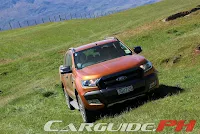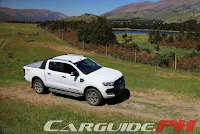 |
| Photos by Ulysses Ang |
Ford doesn’t look at it that way.
The Ranger is a runaway success for Ford for a very simple reason: it doesn’t compromise. From the get-go, Ford understood that pickup customers will demand a range of qualities far greater than the differences in operating condition from country to country. During its development, Ford didn’t simply benchmark the competition with the goal of being better in terms of specifications or technology. Although that’s always going to play a part in the vehicle development process, Ford instead focused on what customers needed and wanted.
Ford didn’t simply build a truck that satisfies the Asia-Pacific market or the European market. They engineered one that satisfies customers everywhere. In short, they challenged themselves to build a Ranger that’s tough yet comfortable, rugged yet stylish, safe, technologically advanced and powerful, yet remaining affordable. Drawing on resources, facilities, and expertise on a global scale, Ford headquartered the Ranger’s development in Australia and understanding this market a bit more as well as One Ford can help you understand why the Ranger has become as competitive as it is.
In the Philippines, the Ranger is the best-selling pickup, but Down Under, not only is it the best-selling pickup (or ute as they call it), but it’s the fourth best-selling nameplate. It does even better in neighboring New Zealand, where it’s the best-selling vehicle overall (in both cases, it has managed to dethrone the Toyota Hilux). That shouldn’t come as a surprise given that Australians and New Zealanders have come to love the Ranger given how they use their pickups.
A walk around Queenstown, New Zealand’s adventure capital, as well as neighboring Wanaka, reveals some local peculiarities here: almost every car’s got a hitch or tow hook installed. Whether it’s a wagon, crossover, pickup, or SUV—they’ve got to be haul-ready on the go. Come to think of it, once the weekend hit, it’s normal to see a beat-up 20-year wagon dragging a trailer loaded with bikes or jet skis. And it’s not just for recreational use, either. In Minaret Station for instance, it’s used as the main workhorse—making sure the entire farm with its 370 kilometers of fencing and 15,000 resident livestock remain in tiptop shape. Such is the demands put on the Ranger and one where it performs beautifully.
Remember the key figures the Ranger is known for such as the 3.5-metric ton towing capacity and one-metric ton payload capacity? It’s hard to imagine, but those figures found in all new-generation pickup trucks are there because of the Ranger. And in turn, those are partially because of customer requirements in markets like Australia and New Zealand. Surefooted towing and hauling is an integral part to a Kiwi’s way of life that Ford doesn’t even offer the smaller engine there. All Rangers come standard with the larger 200-horsepower motor.
Being able to tweak the specifications to meet certain market requirements is another advantage afforded by One Ford. Instead of a having a “take-it-or-leave-it” approach, Ford is able to work with suppliers to develop parts that can be made in the same factory, but look and perform depending on market requirements. And all this is done without fundamentally affecting the design or engineering of a particular vehicle. In short, the Ranger will always be a Ranger wherever it’s sold.
When Then-president and CEO Alan Mulally laid down that vision in 2006, he summed up Ford as a global company, but not acting like one. Since then, the company fine-tuned its operations to wring efficiency and economies of scale. From 27 different platforms, the company has reduced this to just eight. And 99 percent of their products are now produced on those eight common platforms.
Of course the drivetrain forms only a part of that equation; everything else—from the frame, the suspension, brakes, and chassis must all work cohesively. And it does.
The development of a one global Ranger meant Ford leveraged its teams to work around the clock. More than 30,000 computer-aided assessments were done even before the first prototype was built. After that, it was extensively tested and evaluated in 15 countries under the harshest environments from the Australian Outback to the German Autobahn to the Argentinean Pampa. By the time Job One rolled out of Thailand, Ford collectively logged more than a million kilometers of testing on the road.
The Ford Ranger isn’t just the culmination of hard work by almost 500 engineers around the world. It’s the quintessential proof that the One Ford works. It’s sold in more than 180 markets, making it one of the farthest reaching Ford products in the world. And along the way, it has successfully become the leader in its segment. It successfully puts together Ford’s global capabilities, testing facilities, and pickup truck knowledge. It’s capable, comfortable, powerful, fuel-efficient, and safe. It’s a pickup that has captivated the world, but more than anything, it’s a pickup that anyone will be proud to own and confident to drive anywhere and everywhere.













Indeed... im a proud owner, driver and ethusiast here.... way to go power-ful ranger....
ReplyDeleteIndeed... im a proud owner, driver and ethusiast here.... way to go power-ful ranger....
ReplyDeleteWill they include the Sync 3 in this year's release of Ranger or Everest?
ReplyDelete